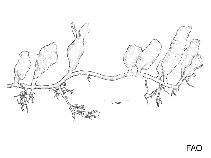Caulerpa chemnitzia (Esper) Lamouroux
Flattop seagrape
Upload your photos
Google image | No image available for this species;
drawing shows typical species in Caulerpaceae.
Google image | No image available for this species;
drawing shows typical species in Caulerpaceae.
Classification / Names Common names | Synonyms | CoL | ITIS | WoRMS
Bryopsidophyceae | Bryopsidales | Caulerpaceae
Environment: milieu / climate zone / depth range / distribution range Ecology
Sessile; brackish; depth range 3 - 6 m (Ref. 80758). Tropical
Distribution Countries | FAO areas | Ecosystems | Occurrences | Introductions
Circumtropical.
Length at first maturity / Size / Weight / Age
Maturity: Lm ? range ? - ? cm
Short description Morphology
Thallus consisting of a horizontal branched stolon and erect branches supporting several short-stalked ramuli, each terminating in a disc. Two forms are recognizable, a more common one with narrow discs, 3 to 9 mm in diameter, and another one with broad discs, 11 to 20 mm in diameter. Erect branches up to 5 cm in height (Ref. 80758).
Used as an antifungal medicine and to lower blood pressure. Also as food (Ref. 80758). Inhabits tidepools at a depth of 3 to 6 m, or forming thick carpets on soft muddy substrates in well-protected areas. Seasonality in growth in sandy-muddy habitats appears to be related to the turbidity and salinity of the water (Ref. 80758). Also in mangrove prop roots and other hard substrates up to 80 m depth (Ref. 83908).
Life cycle and mating behavior Maturity | Reproduction | Spawning | Eggs | Fecundity | Larvae
Main reference
References | Coordinator | Collaborators
Guiry, M.D. and G.M. Guiry. 2009. (Ref. 80701)
IUCN Red List Status (Ref. 130435)
CITES status (Ref. 108899)
Not Evaluated
CMS (Ref. 116361)
Not Evaluated
Threat to humans
Harmless (Ref. 80758)
Human uses
Fisheries: commercial
| FishSource |
Tools
More information
Internet sources
BHL | BOLD Systems | CISTI | DiscoverLife | FAO(Publication : search) | Fishipedia | GenBank (genome, nucleotide) | GloBI | Gomexsi | Google Books | Google Scholar | Google | PubMed | AlgaeBase | Tree of Life | Wikipedia (Go, Search) | Zoological Record
Estimates based on models
Preferred temperature
(Ref. 115969): 24 - 29.2, mean 27.9 (based on 4876 cells).



